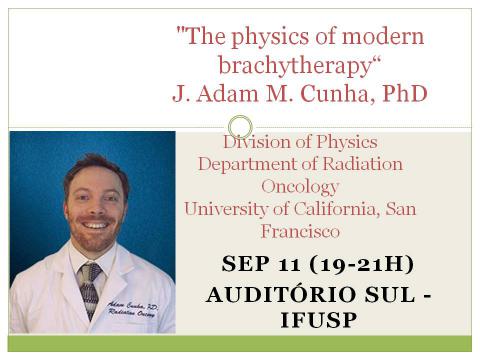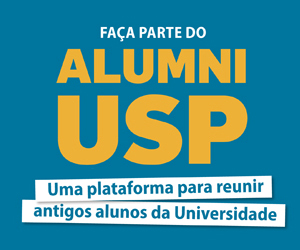
SEMINARY
"The physics of modern brachytherapy"
Professor J. Adam M. Cunha
Helen Diller Family Comprehensive Cancer Center
University of California San Francisco
Sep 11 (19-21h)
Auditório Sul - IFUSP
Abstract:
Brachytherapy is a form of radiotherapy where a radiation source is placed inside or near tissue requiring treatment (“brachys”: Greek for “proximal”). It has a proven track record for the treatment of cancer of the prostate, uterine cervix, breast, skin, and many other disease sites. High dose rate (HDR) brachytherapy utilizes a small (approx. 4 mm x 1 mm cylinder) radioactive source with an activity sufficient to deliver a course of radiation in approximately 10 minutes (with variance due to tumor size and prescription dose).
Brachytherapy utilization in Brazil has seen a significant increase over the last 15 years: from 2001 to 2013 alone there has been an increase of almost 300% in the number hospitals in Brazil with HDR brachytherapy in clinical operation.
This same time period has seen an integration of imaging technology with the ability to resolve soft tissue composition (computed tomography (CT) and magnetic resonance (MR) imaging) into the radiation oncology clinic.
Access to these new imaging technologies, advances in computing power, and new optimization theory has spurred a paradigm shift in what is achievable in brachytherapy practice. While these advances are significant, brachytherapy practice tends to be slow in their uptake; and a significant part of the burden of implementing these advances falls squarely on the shoulders of the medical physicist.
In the last 20 years Brazil has seen a dramatic increase in the number of medical physics programs at both the undergraduate and graduate level. Training of medical physicists in the United States has gone through its own paradigm shift in the last 5 years with an intense focus on establishing national standards for baseline levels of knowledge. Given that a large component of medical physics practice is an applied science field with direct impact on the medical care of patients, this is considered a positive if not essential development.
Strict pathways for advancement through training programs approved by an accreditation body, however, leaves some challenges for ensuring a diversity of background that fosters a creative environment for advancement of the science.
Dr. Cunha is an Assistant Professor of Medical Physics in the Department of Radiation Oncology at the University of California, San Francisco (UCSF). He has been working in the field for almost 10 years and brachytherapy is his primary clinical and research focus. UCSF is a world leader in both the clinical practice of brachytherapy and cutting edge brachytherapy research. In this lecture series, Prof. Cunha will cover an even distribution of both the latest in the field as a whole and his own work in the field.
Publico alvo: alunos de graduação e pós-graduação interessados em Física Médica
Fonte das informações:
Grupo de Dosimetria das Radiações e Física Médica
Prof. Paulo Roberto Costa
(11) 3091-7005
E-mail: pcosta@if.usp.br
Data do Evento:
11/09/2017 - 19:00 até 21:00
Data de Término:
11/09/2017 - 19:00













